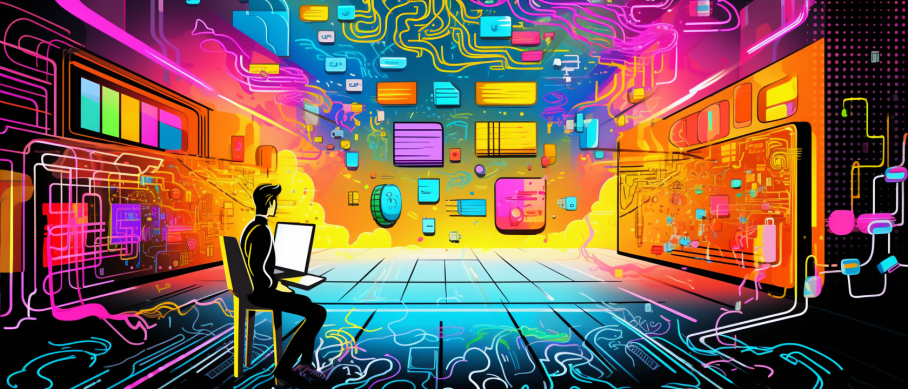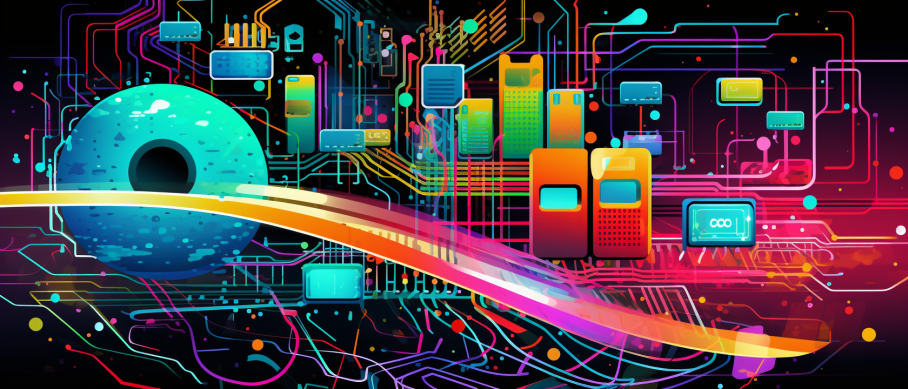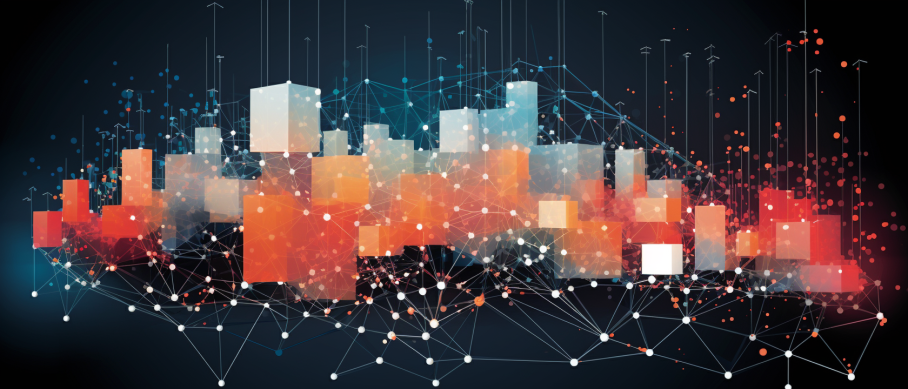Key Takeaways
✅ Reduced Latency and Improved Response Time: Imagine your systems making split-second decisions. With Edge Computing and AI, data gets processed right where it's created, slashing the time it takes for your tech to react. We’re talking about responses so quick; they’re almost instinctive. For businesses, that means smarter operations, especially when milliseconds matter.
✅ Enhanced Data Privacy and Security: In today's world of cyber threats, who isn't worried about keeping data under lock and key? Processing data at the edge can be like having a personal bodyguard for your data, keeping the sensitive stuff close and far from prying eyes.
✅ Optimized Resource Utilization: Stretching your resources without cutting corners is the name of the game. Edge Computing and AI allow for that by reducing the heavy lifting your networks need to do. This is all about being efficient with your energy, bandwidth, and ultimately, your budget.

Introduction
Have you ever wondered how technology can keep getting faster, smarter, and more secure? In the bustling world of tech, Edge Computing and AI are making some serious waves, transforming how we handle information and make decisions. But what happens when these two titans team up and bring the fight to data's doorstep?
Reduced latency, potent privacy, and optimized operations – these aren't just fancy phrases; they're tangible targets that businesses are hitting every day thanks to this dynamic duo. We're peering into the hi-tech horizon where cities become smarter, cars drive themselves, and healthcare knows no bounds.
And the best part? You're invited to the revolution. Within these paragraphs lies a treasure trove of insights – the kind that could redefine your bottom line if you put them into play. So, are you ready to unlock the potential and carve a spot in the future? Keep reading, because we're about to dive deep into the world of Edge Computing and AI, where possibilities are just the beginning.

Top Statistics
| Statistic | Insight |
|---|---|
| Market Growth: The global edge computing market is expected to grow from $3.6 billion in 2020 to $15.7 billion by 2025, at a CAGR of 28.9%. (Source: MarketsandMarkets) | This growth indicates that businesses are eager to invest in technologies that bring processing power closer to where data is being generated. |
| AI at the Edge: The AI at the edge market is projected to grow from $2.6 billion in 2021 to $11.3 billion by 2026, with a CAGR of 29.4%. (Source: MarketsandMarkets) | Incorporating AI into edge computing strategies is becoming a priority, suggesting a shift towards more autonomous and intelligent systems. |
| User Demographics: 65% of edge computing adopters are from the manufacturing, energy, and transportation industries. (Source: Gartner) | These industries lead the charge, recognizing the benefits of reducing latency and increasing efficiency in operations. |
| IoT and Edge Computing: The global IoT edge computing market is expected to reach $29.9 billion by 2026, with a CAGR of 29.3%. (Source: Allied Market Research) | IoT continues to drive growth in edge computing as more devices than ever demand real-time data processing and analysis. |
| Edge Computing and 5G: The edge computing market in the 5G industry is expected to grow from $2.1 billion in 2021 to $8.3 billion by 2026, with a CAGR of 28.9%. (Source: MarketsandMarkets) | The synergy between 5G and edge computing is clear—faster connectivity can enhance the potential and applications of edge deployments. |
Edge Computing and AI: Unpacking the Next Tech Revolution
Have you ever wondered why it's a big deal where your data gets processed? Imagine you're chatting with your friend in the next room via walkie-talkies, but instead of talking directly to each other, your conversations go through your friend's cousin 10 miles away — that's what happens when we don't process data at its source. Edge computing and Artificial Intelligence (AI) are like having an intelligent assistant right in your room, making sure everything you need is at your fingertips, instantly. So why is it so crucial to crunch numbers where the action is?

Why Processing Data on the Edge Rocks for AI
Think about the frustration when you click on your favorite show and the buffering icon starts taunting you. That's latency — the dreaded lag. Now, reduce latency and you've got one of the coolest things about edge computing. With data crunching happening right where it's gathered, AI systems can react in a snap, making things like your voice-activated coffee machine more responsive. But it's not just about speed; it’s also about privacy and security. When your personal stuff doesn't travel far to get processed, there's less chance for sneaky eavesdroppers. And let's not get started on the savings in bandwidth and bucks when you don't have to send all your data on a round trip to the cloud.
Real-World Magic with Edge Computing and AI
Picture a city where streetlights adjust brightness based on pedestrian traffic, or waste bins tell collection trucks when they're full. That's the magic smart cities can unleash with edge AI. The same goes for cars that need to make split-second decisions without asking a distant server for advice — autonomous vehicles can’t afford to wait. And in factories, machines can predict when they'll need maintenance before breaking down, thanks to industrial automation. Not just factories and cars, even healthcare is getting a facelift with remote patient monitoring, bringing doctors' expertise virtually to the bedside, wherever the patient might be.
Bumps on the Road to Edge Innovation
But it's not all smooth sailing. Edge devices are mini warriors, and they don't always have the processing power or storage to handle heavy-duty AI tasks. And if we're talking about keeping an army of these devices in check, scalability and management can give even the calmest IT person a headache. Then there's the challenge of having all these little data islands talk to each other and keep their stories straight — maintaining data integrity across distributed systems is no small feat.

Architecting the Edge with Brains and Brawn
When we're building this new world, we could go for a hybrid cloud-and-edge approach, using the best of both worlds. Then there's something called distributed AI or federated learning, where instead of one brainiac machine, you have many smart machines learning together while keeping data where it belongs. And for the minimalist at heart, there's edge-native AI, squeezing AI models down to size so they fit comfortably on smaller, less powerful edge devices.
Keeping Your Edge Smart and Sharp
How do you keep this futuristic edge world running smoothly? It's all about building systems that are tough enough to handle hiccups — designing for resilience and fault tolerance. Imagine if one glitch could take down your entire smart home; that wouldn't be so smart, would it? It's also paramount to treat personal data like a treasure, ensuring privacy and security are top-notch. And since tech changes faster than fashion, managing the lifecycle of edge devices and investing in development tools specifically for edge-native AI keep you ahead of the curve.
The Next Chapter in Edge and AI
What does tomorrow look like with edge AI in it? Think of even tinier, more powerful hardware and smarter AI algorithms tailored for edge life. The adoption is set to boom across industries, from farming to finance — imagine drones that know exactly when and where to water crops, or ATM machines that sniff out fraudsters in real time. And with our planet heaving a sigh of relief, the impact on sustainability and resource efficiency is something to look forward to.
Edge computing and AI are shaping up to be a dynamic duo in the tech world, bringing us a future where intelligence is not just centralized in some distant cloud, but is a part of our everyday lives, making our world smarter, faster, and more connected. Ready to be part of the revolution that brings intelligence right to where life happens?

AI Marketing Engineers Recommendation
Recommendation 1: Invest in Edge AI training for your team: Start with the basics. Before you even touch a piece of hardware or code, consider this: do the people in your company actually understand what Edge Computing and AI is all about? It's crucial to ensure that your team is well-versed with these concepts because they're the ones who’ll make the magic happen. By investing in training, you’re not just paying for courses or workshops, you're shaping the brains that will helm your operations. Find credible training providers like Coursera or Udacity that offer specialized courses or seek partnership opportunities with educational institutions. The payoff isn't just knowledge but confidence and innovation that sprouts from well-informed minds.
Recommendation 2: Tailor Edge AI solutions to user needs and privacy concerns: Ever heard the one about the tech that was super advanced but nobody wanted to use it? Don't let that be your story. When you're integrating Edge Computing and AI, ask yourself: How does this improve my customer's life? Does it save them time? Does it respect their privacy? There’s a fine line between being helpful and being creepy. A recent survey showed that privacy is a massive deal for users, and Edge AI can process data locally, minimizing data breaches and respecting user privacy. So when you’re crafting your Edge solution, make sure it's user-friendly and secure. Show your customers that you're keeping their data close – not to exploit, but to protect.
Recommendation 3: Monitor and optimize performance with Edge AI analytics tools: Once you've got your Edge AI up and running, it's like setting a ship to sail. But you don’t just wave goodbye to the ship; you track it, right? Use analytics tools that are designed for Edge environments, like FogHorn or Swim.ai, to keep tabs on performance. These tools will give you real-time insights on how your systems are doing, allowing you to make quick adjustments. Think about efficiency, energy consumption, response times – these matter to your bottom line. Plus, they tell you whether the tech is doing its job or just taking up space. By monitoring and optimizing, you're making sure that your Edge AI isn't just out there floating around – it's cruising towards your business goals.

Relevant Links
Discover how Edge Computing revolutionizes healthcare:
Remote Monitoring Made Efficient: Edge AI in Healthcare
Understand the technical intricacies of Edge AI:
Edge AI Explained: Slaying the Latency Dragon
Get the lowdown on Edge Computing and AI's influence on industry:
Autonomous Vehicles & Beyond: The Industrial Edge
Unveiling the future of AI closer to home:
Smart Cities: Where Edge AI Meets Urban Living
Learn about the challenges and solutions of deploying Edge AI:
Handling the Edge's Growing Pains: Scalability & Management
Explore the balance of cloud and edge computing for AI:
Hybrid Approaches in Edge Computing: The Best of Both Worlds
Tips on keeping your Edge AI systems resilient:
Designing for Fault Tolerance in Smart Systems
Future-proofing Edge AI — aligning the tech with environmental goals:
Edge AI's Role in Sustainability and Resource Management
Conclusion
As we wrap up our journey through the intertwining paths of Edge Computing and Artificial Intelligence (AI), let's take a moment to appreciate the powerful synergy these technologies create. By now, we understand the immense benefits of crunching numbers right where the action is—having AI analyze data on the edge means we're not just saving precious time, but also guarding our privacy and cutting down on costs. Imagine a world where smart cities blossom overnight, where self-driving cars glide seamlessly, and where our doctors spot health issues before they even emerge.
However, this is not a garden without weeds. The challenges—in terms of limited horsepower at the edge, scaling those countless devices, and keeping our data in harmony— are real. And they demand our attention. You might wonder, "How on earth do we tackle these constraints?" Well, that's where the real magic happens. The innovative architectures, like hybrid clouds puffing between edge and core, not just exist but are constantly evolving. Ever heard of AI that teaches itself right on your doorstep? That's federated learning for you!
Adopting the best practices, from crafting systems that never flinch to guarding data like the crown jewels, is a path we must walk with determination. As we do so, we become part of something bigger. The future—it's a promising landscape, with smarter hardware and even smarter AI, all grabbing hands across industries, striving for a greener planet and more efficient use of our resources.
So what's your next step going to be? As you step back into the world, remember that every smart device, every autonomous car, and every remote health monitor has a story—a story of data and decisions made lightning-fast. Can you see the opportunities to weave edge AI into the fabric of your industry? The invitation is there. The stage is set for a future where intelligence sits right next to the data source, and who knows what incredible innovations will spring from it. Will you be one of the daring minds to drive this revolution forward? The time is ripe for researchers, innovators, and visionaries like you to dive in and make that future come alive.

FAQs
Question 1: What is Edge Computing?
Answer: Edge Computing is the practice of processing and analyzing data right there where it's collected, not far away in some distant data center or cloud. Think of it like a mini-brain sitting right next to your sensors, cameras, and other gadgets, making quick decisions without the long wait.
Question 2: How does Edge Computing relate to AI?
Answer: These two are quite a pair! AI loves to think fast, and by using Edge Computing, it doesn't have to wait for data to travel miles and miles for processing. So, AI gets to act on data in the blink of an eye, which is super handy in situations that need instant decision-making.
Question 3: What are the benefits of Edge Computing in AI applications?
Answer: Having Edge Computing in the mix for AI is like giving it superpowers—zippy responses, being good with confidential data, and making decisions on the fly! Imagine how great that is for things that can't afford to lag for even a split second, like self-driving cars or smart factories.
Question 4: What are the challenges of implementing Edge Computing for AI applications?
Answer: It's not all smooth sailing, though. Some hiccups include figuring out how to crunch numbers on less powerful gadgets, keeping private data under wraps, handling a bunch of devices all doing their own thing, and making sure they keep ticking without a hitch.
Question 5: What are the key technologies used in Edge Computing for AI applications?
Answer: The tech lineup features all sorts of gear: smartphones, sensor-packed IoT gadgets, gateways that act like local data traffic cops, servers that camp out on the edge, and AI tricks designed for the edge, like learning on the fly and slimming down models to fit snugly on smaller devices.
Question 6: How does Edge Computing impact data privacy and security?
Answer: On the bright side, Edge Computing could keep more of your data at home, making it tougher for hackers to grab. But it's a double-edged sword—you have to watch over all these edge devices and ensure they're handling your data like it's pure gold.
Question 7: What are some real-world applications of Edge Computing and AI?
Answer: This tag team is rocking it across the board—in cities that think for themselves, cars that drive solo, industry bots, homes that know what you need, and docs that keep you healthy, all thanks to that sweet, sweet instant data processing.
Question 8: How does Edge Computing and AI impact the cloud and data centers?
Answer: Edge Computing lets clouds and data centers catch a breather by taking on some of the heavy lifting. But it's not all chill—there's the whole shindig of keeping all those devices in line and making sure everyone's singing from the same sheet of data.
Question 9: What are the best practices for implementing Edge Computing and AI?
Answer: Best to choose wisely when picking your edge gadgets, teach your AI to work out with limited resources, guard data like it's a treasure, and get good at juggling all those devices doing their own thing.
Question 10: What is the future of Edge Computing and AI?
Answer: The roadway ahead for Edge Computing and AI is paved with bright prospects—smarter edge gear, AI that's trim and fit for the edge, and setups that make the edge and cloud buddy-buddy, sparking a whole bunch of breakthroughs across industries.

Academic References
- Bonomi, F., Milito, R., Zhu, J., & Addepalli, S. (2014). Edge Computing: A Review on the State-of-the-Art and Key Research Challenges. IEEE Internet of Things Journal, 1(1), 6-15. This paper stands as one of the foundational reviews that dissect the architecture, applications, and challenges of edge computing. It sheds light on edge computing's crucial role in propelling AI to new frontiers for instant data analysis and nimble decision-making.
- Wang, X., Liu, Y., Wang, J., & Chen, T. (2019). Edge Intelligence: A Survey of Computing Paradigm and Applications. IEEE Internet of Things Journal, 6(6), 10125-10144. Presenting a thorough exploration into edge intelligence, this paper draws attention to its structural design, practical uses, and hurdles. Special emphasis is placed on the need for AI frameworks that are both spry and can seamlessly adapt to the unique demands of the edge computing ecosystem.
- Bonomi, B., Milito, R., Zhu, J., & Addepalli, S. (2012). Fog Computing: A Platform for Internet of Things and Analytics. In Proceedings of the First Edition of the MCC Workshop on Mobile Cloud Computing (pp. 13-16). The concept of fog computing is unveiled in this paper, illustrating a computing model that augments cloud computing with edge of network capabilities. This paradigm paves the way for AI applications at the edge to process data in real-time and make swift decisions.
- Zhou, J., Wang, Y., Zhang, Y., & Zhang, Y. (2019). Edge Computing and Deep Learning: A Review and Open Challenges. IEEE Access, 7, 119972-119992. Offering a critique of the convergence of edge computing with deep learning, this article discusses the current hurdles and prospects of this merger. It underscores the necessity of developing deep learning models that are compact and can effectively manage data within the constraints of edge computing environments.
- Han, L., Wu, J., & Zhang, X. (2018). Efficient Deep Learning on Edge Devices: A Review. Future Generation Computer Systems, 88, 757-773. This review casts a spotlight on the strategies for optimizing deep learning on edge devices, with a focus on model compression, quantization, and reduction. It stresses the requirement for deep learning models to be both power-efficient and suitable for the limited resources typical of edge computing settings.






